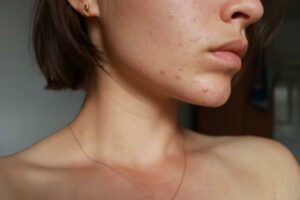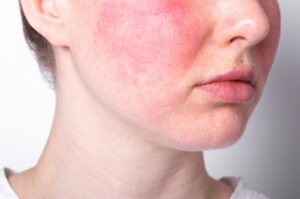Is your skin dry, cracked, and itchy? You could have eczema.
If you’re among the over 30 million Americans suffering from eczema, you may know that dry skin leads to increased eczema flare-ups. Fortunately, you can help your skin retain moisture and find relief from the symptoms of eczema.
Keep reading to learn more about eczema and how to banish dry skin from eczema with these 3 tips.
What Is Eczema?
Eczema is a skin condition that causes inflammation, itching, dry skin, rashes, scaly patches, and infection. The condition weakens the skin’s barrier function, which helps the skin retain moisture and safeguards your body from external elements.
Emily McKenzie, MD, a dermatologist at Golden State Dermatology in Alamo, CA, explains: “Eczema is more than just dry skin. It’s a complex condition that affects the skin’s ability to protect itself, leading to increased sensitivity and inflammation. Understanding this is crucial for effective management.”
Inflamed skin due to eczema tends to look red on lighter skin tones. Eczema typically appears gray, ashen, brown, or purple for darker skin.
Eczema isn’t contagious and often comes and goes over time. A return of eczema symptoms is known as a flare-up. These flare-ups can last anywhere from weeks to months.
There are different types of eczema. The most common is atopic eczema or atopic dermatitis.
What Are the Symptoms of Eczema?
The symptoms of atopic eczema may appear anywhere on the body. They can disappear for some time before flaring up again. These symptoms may include:

- Itchiness
- Redness
- Dry, cracked skin
- Thick, leathery skin
- Rash on swollen skin
- Oozing and crusting
- Raw, sensitive skin due to scratching
- Tiny raised bumps on black or brown skin
How Can You Banish Dry Skin from Eczema?
Dry skin from eczema can cause irritation and flare-ups. Treating dry skin and eczema effectively often requires multidisciplinary management. You can curb dry skin with these tips:
1. Moisturize Your Skin Regularly
Water loss is higher in patients with eczema, leading to dry skin and itchiness. The drier your skin, the more it will feel itchy and likely cause a flare-up.
Eczema damages the skin barrier, which makes it difficult for the skin to retain water, resulting in chronically dry and itchy skin. A damaged skin barrier also makes skin more sensitive to allergens, irritants, and bacteria.
Using a gentle moisturizer frequently can help control dry skin caused by eczema and protect the skin barrier. Gentle formulas keep your symptoms from worsening.
Not all moisturizers are created equal. The most effective are moisturizing ointments and creams.
They contain more oil than water, which adds deeper moisture to the skin, combating dry skin and eczema. When choosing a cream or ointment, go for products labeled “fragrance-free,” “for sensitive skin,” and “hypoallergenic.”
Avoid products with ingredients including retinol, glycolic acid, and salicylic acid, as these tend to dry out and irritate the skin.
How to Apply Moisturizer

Apply the moisturizer after a warm shower or bath when your skin is slightly damp. Applying moisturizer while your skin is still damp and retaining some water locks in moisture and prevents water loss from dehydration.
For maximum effect, use the moisturizer twice daily, whether you have a flare-up or not. Moisturizing is crucial for rehydration, promoting skin recovery, and decreasing the frequency and severity of eczema flare-ups.
Also, apply moisturizer every time your hands get wet. If you’re using a prescription topical cream or ointment, apply it as directed before moisturizing.
Your dermatologist at Golden State Dermatology will recommend how long you should wait for the topical medication to be absorbed adequately before applying your moisturizer.
2. Use Topical Prescription Steroids
Your dermatologist can prescribe topical steroids, also called corticosteroids, to treat dry, flaky patches associated with the inflammation caused by eczema. Topical prescription steroids reduce inflammation and itching, allowing your skin to start healing.
Topical steroids are available in different forms, including ointments, creams, gels, and lotions. There are seven classes of topical steroids, depending on their strength, with class 1 being the most potent.
Your dermatologist at Golden State Dermatology will prescribe the most appropriate dosage based on the severity of your eczema.
3. Take Lukewarm Showers and Baths
People with eczema typically have incredibly dry skin. When the skin is dry, it doesn’t contain sufficient oil.
Bathing or showering is an essential part of your daily routine. However, long baths or showers, hot water temperatures, and soaps can be too harsh on your skin and lead to dry skin, which may aggravate your eczema, leading to a flare-up.
Lukewarm water can add much-needed moisture to your skin, alleviating dryness and reducing flare-ups. Dermatologists recommend the soak and seal method to fight dry skin when showering or bathing.
The soak and seal method entails getting your skin wet when showering or bathing and sealing in the water on your skin with a good moisturizer. To experience the full benefits of soak and seal to quench dry skin, follow this order:
- Bath or shower with lukewarm water for 5 to 10 minutes to avoid drying out your skin
- Use a gentle, soap-free cleanser. Skip the loofah, washcloth, or sponge. Instead, lather with your hands.
- Once done, gently pat your skin with a clean towel (washed in fragrance-free detergent) and leave it slightly damp.
- Apply topical medication if you have one. Wait as directed to let the medication absorb into your skin.
- Finish off with a moisturizer. Ideally, this should be within 3 minutes after taking a shower or applying topical medication. Let the moisturizer sit for a few minutes to allow it to sink in before getting dressed. Wear eczema-friendly clothes. Fabrics such as 100 percent silk, bamboo, and cotton are less irritating.
When At-Home Remedies Aren’t Enough
For patients whose symptoms are not adequately managed by at-home or over-the-counter remedies, a visit to your dermatologist can help you turn things around. Topical prescription options include corticosteroids, which effectively reduce inflammation and itching, and non-steroidal topical alternatives like calcineurin inhibitors (e.g., tacrolimus and pimecrolimus), JAK inhibitors (ruxolitinib) and phosphodiesterase inhibitors (such as crisaborole), which are particularly useful for sensitive areas.
For more severe cases, systemic treatments like biologics (such as dupilumab) and JAK inhibitors (including abrocitinib and upadacitinib) offer targeted therapies that help modulate the immune response. These advanced treatment options are only available through a dermatologist, who can assess the condition’s severity and tailor a treatment plan that addresses the unique needs of each patient.
Keep Dry Skin and Eczema at Bay

Dr. McKenzie adds: “While managing eczema can be challenging, consistency in your skincare routine is key. Regular moisturizing, proper bathing techniques, and appropriate use of medications can significantly improve your skin’s health and reduce flare-ups.”
Golden State Dermatology offers comprehensive, individualized care for eczema. Our goal is to alleviate dry skin and eczema in patients so they can enjoy healthy skin and a better quality of life.
Are you struggling with eczema? Book your appointment at Golden State Dermatology to get on the path to long-term relief.







